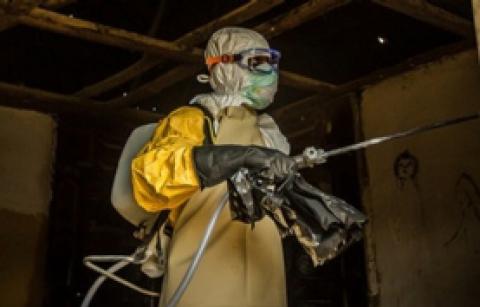At the epicenter of the Ebola outbreak there are finally flickers of hope. Wednesday the World Health Organization reported that even in the absence of new vaccines and medications there have been some significant strides against the virus in Liberia, the country hardest hit by the epidemic. The cautious optimism has set off discussion about what the “next phase” of the Ebola response may entail: even more aggressive tracing of people possibly exposed to Ebola.
The number of cases in Liberia, a top WHO official said Wednesday, may be dropping by as much as 25 percent a week. “It appears the trend is real in Liberia,” Bruce Aylward, WHO assistant director general in charge of the operational response said in a press briefing. “There may indeed be a slowing of the epidemic there.”
In west Africa there are still more than 13,500 Ebola cases—actually an uptick of about 3,000 in recent days—but a significant portion of those actually come from earlier reporting delays, WHO says. About half of the reported cases are in Liberia but WHO reported in its October 29 update on the outbreak that the weekly increases in new cases “appears to have halted since mid-September, with a reduction in number of confirmed and probable cases reported in the week ending 5 October.” Fewer burials, the agency says, also suggests these numbers reflect reality.
Yet possible administrative hiccups, missing data and underreporting still leave officials unsure about if those figures are a true picture of the situation in Liberia. And until the country follows in the footsteps of Nigeria and Senegal, which are considered Ebola-free because they have not reported any cases within their borders for more than 42 days, Liberia is still at significant risk of a resurgence. Indeed, earlier optimism about Liberia months ago, when case numbers appeared to be dropping, was quickly dashed once the virus spread to the nation’s capital, Monrovia, and ravaged the city’s residents.
Exactly why the numbers may have dropped in Liberia this time also is difficult to trace. A combination of factors—more hospital beds, better communication about Ebola prevention, better burial practices and better follow-up with potentially exposed individuals could have all contributed to Liberia’s successes, according to WHO. Still, even if the figures are accurate, that doesn’t mean the worst is over and the outbreak is under control. “That’s like saying your pet tiger is under control,” Aylward warned. It would be very easy for the country to backslide. Just one new Ebola patient could set off a whole new chain of transmission, he said.
But for now the data looks encouraging and suggests “classic Ebola control strategies can work on a larger scale,” Aylward said. His words echo what is also being seen by health care workers in Liberia. "Instead of two big wild fires that yielded many cases we now have several small-and medium-sized wildfires in at least half of the 15 counties,” says Hans Rosling, advisor to the chief of epidemic statistics at Liberia’s Ministry of Health and Social Welfare. Now, Rosling tells Scientific American, the response to the outbreak is entering a new phase that “is in many ways more complex to deal with and requires much more resources per case.”
WHO agrees: “The strategies that get you to here right now are not the strategies that you get to zero ,” Aylward emphasized. Whereas earlier response efforts focused on getting enough man power and beds on the ground, the next phase will entail more aggressive tracking of patients and any individuals they may have encountered—an arduous undertaking.
Even as the focus may move toward a next phase of the response in some areas, WHO stresses that international aid cannot let up and more resources are urgently needed. Although some hospital beds in Liberian care centers are empty, for example, the country still needs more beds in rural areas where patients still cannot access care. The agency says there are only 15 Ebola treatment centers in some of the hardest hit areas in west Africa whereas the region needs 56. Moreover, cases are continuing to rise in neighboring Guinea and Sierra Leone; Mali also reported its first case last week and people that came into contact with that individual are being carefully watched.
The message comes even as controversy about quarantine policies for returning health care workers in the U.S. has prompted Doctors Without Borders to warn that such action by states and local government could have a chilling effect on the organization’s ability to help tamp down Ebola in west Africa. “The risk of being quarantined for 21 days upon completion of work has already prompted some people to reduce their length of time in the field. Others will be less inclined to volunteer in the first place,” the organization said, in a statement. The call for action was also echoed from the White House East Room: “The struggle is far from over,” Kent Brantly, the first patient treated for Ebola in the U.S., reiterated at a White House press briefing this week. “More medical personnel are desperately needed.”
Reporting contributed by David Biello


Spread the word